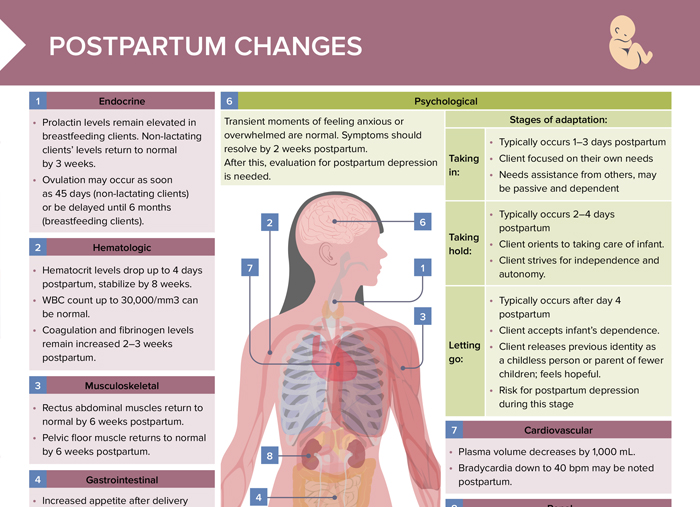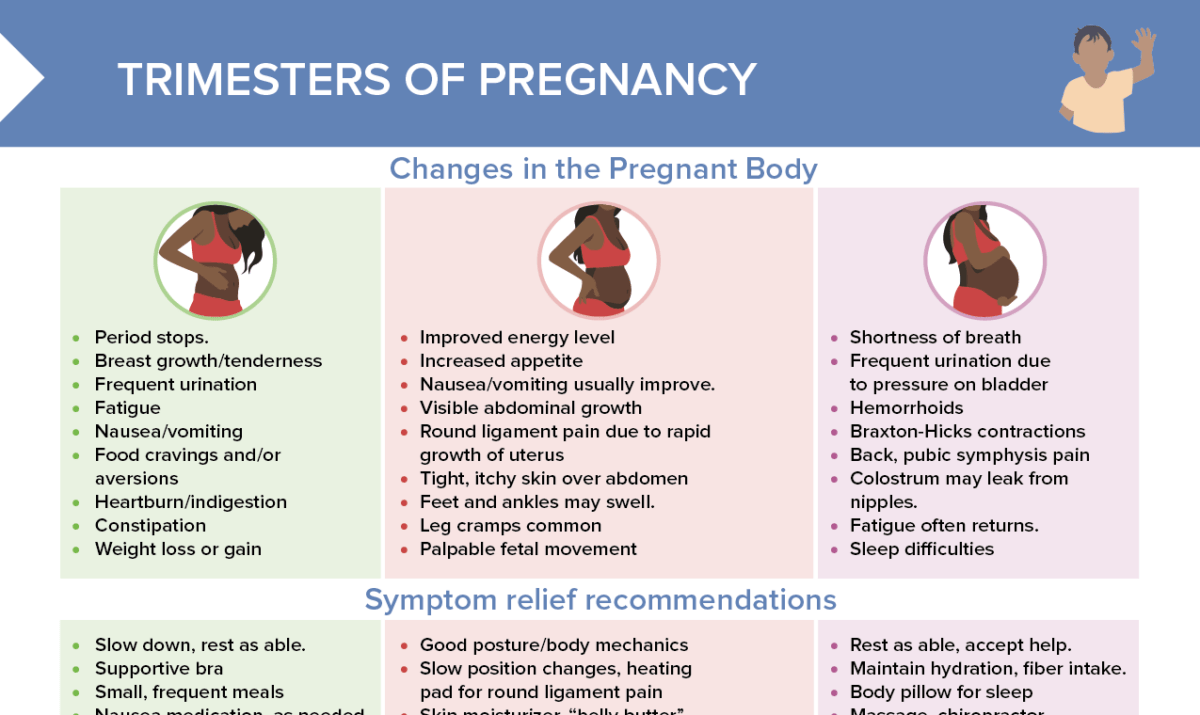What are the trimesters of pregnancy?
Pregnancy is typically divided into trimesters:
- First trimester: weeks 1–12
- Second trimester: weeks 13–26
- Third trimester: weeks 27–40
These divisions help healthcare providers and expecting parents track the development of the fetus and manage the different stages of pregnancy. Nurses often tailor care and education to the specific needs and risks associated with each trimester.
Sometimes, the first three months postpartum are informally referred to as “the fourth trimester,” being an extension of the baby’s development and adjustment to the outside world, as well as being a time of significant physical and emotional changes and challenges for the mother.
Related videos
First trimester of pregnancy
Bodily changes in the first trimester:
- Period stops.
- Breast growth/tenderness
- Frequent urination
- Fatigue
- Nausea/vomiting
- Food cravings and/or aversions
- Heartburn/indigestion
- Constipation
- Weight loss or gain
Symptom relief recommendations in the first trimester:
- Slow down, rest as able.
- Supportive bra
- Small, frequent meals
- Nausea medication, as needed
- Avoid heartburn triggers.
- Increase fluid, fiber intake.
Changes in the embryo/fetus in the first trimester:
- Implantation of fertilized egg
- Embryo; weeks 5–10
- Development of brain, spine
- All organ systems form.
- Limbs and digits develop.
- Fetus starting at 11 weeks
- Breathing and swallowing movements
Second trimester of pregnancy
Bodily changes in the second trimester:
- Improved energy level
- Increased appetite
- Nausea/vomiting usually improve.
- Visible abdominal growth
- Round ligament pain due to rapid growth of uterus
- Tight, itchy skin over abdomen
- Feet and ankles may swell.
- Leg cramps common
- Palpable fetal movement
Symptom relief recommendations in the second trimester:
- Good posture/body mechanics
- Slow position changes, heating pad for round ligament pain
- Skin moisturizer, “belly butter”
- Magnesium supplement for leg cramps
- Stay active; swimming, prenatal yoga
Changes in the embryo/fetus in the second trimester:
- Organ systems continue to develop.
- Bones hardening, skin thickening
- Fine hair covers the skin.
- Fetus can hear sounds.
- Movements more coordinated
- Lungs begin to make surfactant.
- Increased body fat
- Fingerprints and footprints form.
Third trimester of pregnancy
Bodily changes in the third trimester:
- Shortness of breath
- Frequent urination due to pressure on bladder
- Hemorrhoids
- Braxton-Hicks contractions
- Back, pubic symphysis pain
- Colostrum may leak from nipples.
- Fatigue often returns.
- Sleep difficulties
Symptom relief recommendations in the third trimester:
- Rest as able, accept help.
- Maintain hydration, fiber intake.
- Body pillow for sleep
- Massage, chiropractor, pregnancy support belt
- Educate on Braxton-Hicks vs labor contractions, birth preparation
Changes in the embryo/fetus in the third trimester:
- Organ development complete
- Gaining weight rapidly
- Rapid brain development
- Bone marrow makes RBCs.
- Eyes open/close, sense light.
- Lungs continue to develop.
- Head-down position for birth
How long are pregnancy trimesters?
Each pregnancy trimester lasts roughly 13–14 weeks.
How are pregnancy trimesters divided?
A normal pregnancy is evenly divided into 3 parts, the pregnancy trimesters.
They each have specific developmental milestones and medical considerations defining them:
- First trimester: focused on early development, organ formation, and confirmation of pregnancy
- Second trimester: growth of the fetus; stabilization of maternal symptoms
- Third trimester: final growth and development of the fetus; preparation for birth
Presumptive signs of pregnancy
Presumptive signs of pregnancy are symptoms that suggest a woman might be pregnant but are not definitive. They include:
- Missed period
- Morning sickness
- Breast tenderness
- Increased urination
- Fatigue
These signs are not exclusive to pregnancy and can be caused by other conditions. For a definitive diagnosis, diagnostic tests like urine or blood tests and ultrasounds are necessary. Nurses should guide women experiencing these symptoms to seek medical confirmation.
Nursing diagnosis for pregnancy
Potential nursing diagnoses for pregnancy include:
- Imbalanced nutrition less than body requirements related to nausea or dietary restrictions
- Fatigue related to increased metabolic demands and hormonal changes
- Knowledge deficit related to pregnancy, labor, and newborn care
- Anxiety related to upcoming labor, delivery, and parenting responsibilities
- Ineffective coping related to stressors associated with pregnancy
- Interrupted family processes related to addition of a new family member
- Risk for deficient fluid volume related to vomiting from morning sickness
- Risk for injury related to altered center of gravity or hormone-induced ligamentous laxity

